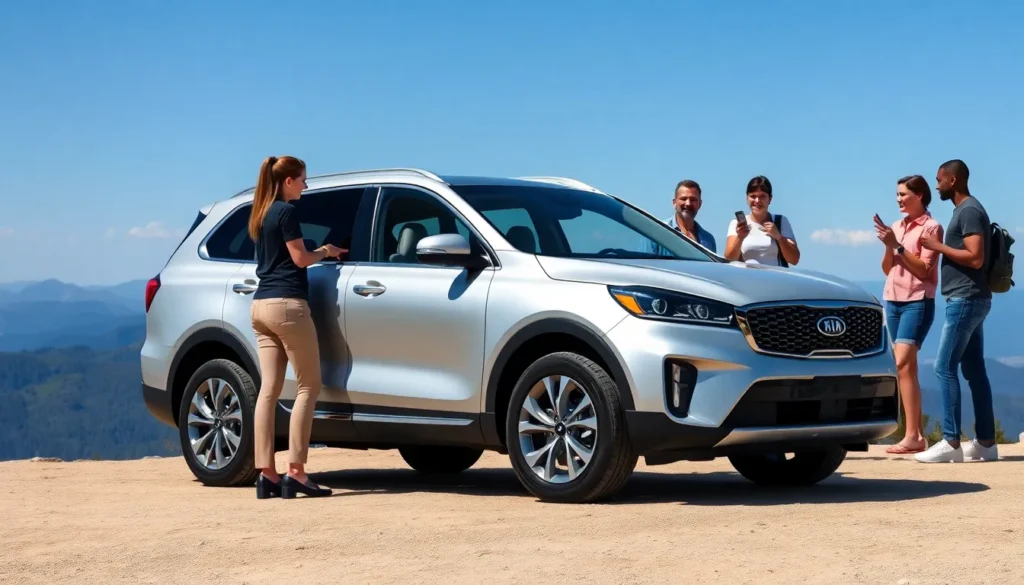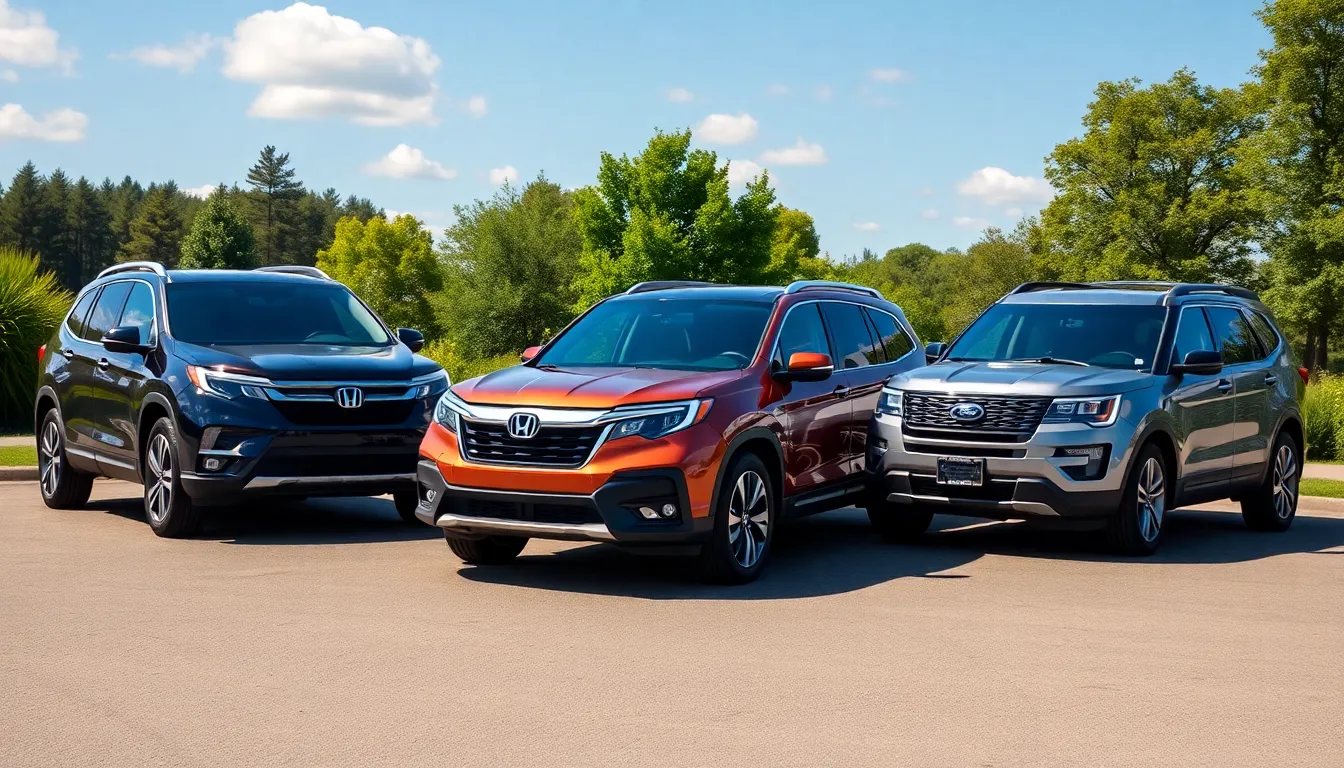
In the crowded mid-size SUV market, the Kia Sorento stands out for its blend of style, technology, and practicality. As consumers seek vehicles that offer both comfort and versatility, the Sorento faces stiff competition from several key players. Understanding these competitors is essential for anyone considering a new SUV, as it highlights the unique features and advantages each model brings to the table.
From the rugged Toyota Highlander to the spacious Honda Pilot, each rival offers distinct qualities that cater to different lifestyles and preferences. This article dives into the top competitors of the Kia Sorento, examining their strengths and weaknesses to help potential buyers make informed decisions. Whether it’s advanced safety features, fuel efficiency, or interior space, knowing the competition can make all the difference in choosing the perfect vehicle.
Overview of Kia Sorento Competitors
The Kia Sorento faces strong competition in the mid-size SUV market from several key players. This section examines notable rivals including the Toyota Highlander, Honda Pilot, Ford Explorer, and Subaru Ascent, each bringing distinct features appealing to different consumer preferences.
Toyota Highlander
- Performance: The Highlander offers a choice of gasoline or hybrid powertrains, catering to drivers who prioritize fuel efficiency.
- Interior Space: It features three rows of seating, accommodating up to eight passengers, making it ideal for growing families.
- Technology: Standard safety features include Toyota Safety Sense, enhancing driver confidence on the road.
Honda Pilot
- Versatility: The Pilot stands out with its spacious cabin, equipped with seating for up to eight people and ample cargo space.
- Engine Options: It boasts a robust 3.5-liter V6 engine, providing a balance of power and efficiency.
- Safety Ratings: The Pilot consistently earns high safety ratings, thanks to advanced safety features like Collision Mitigation Braking.
Ford Explorer
- Performance: The Explorer delivers a sporty driving experience with multiple engine options, including a turbocharged four-cylinder and a powerful V6.
- Towing Capacity: It offers impressive towing capabilities, making it suitable for adventure enthusiasts with trailers or boats.
- Technology: Ford’s SYNC technology integrates seamlessly with smartphones, enhancing connectivity for drivers.
Subaru Ascent
- All-Wheel Drive: The Ascent comes standard with all-wheel drive, appealing to those needing extra traction in various weather conditions.
- Safety Features: It includes EyeSight Driver Assist Technology, which contributes to high safety ratings and reliability.
- Roominess: With three rows of seating and generous cargo space, the Ascent caters to families looking for practicality.
Understanding these competitors’ strengths and weaknesses provides valuable insights for buyers considering the Kia Sorento. Each model delivers unique benefits, influencing consumer decisions based on specific requirements such as safety, efficiency, and space.
Key Competitors in the Midsize SUV Market

The midsize SUV market features several strong competitors to the Kia Sorento, each offering distinct advantages. Understanding these models helps in evaluating the Sorento’s positioning against consumer preferences.
Toyota Highlander
The Toyota Highlander excels with its fuel-efficient gasoline and hybrid powertrains, delivering up to 36 mpg in the hybrid variant. This SUV accommodates up to eight passengers with three rows of spacious seating. Standard safety features include Toyota Safety Sense, enhancing peace of mind for families. Available all-wheel drive further adds versatility, making the Highlander suitable for various driving conditions.
Honda Pilot
The Honda Pilot offers a versatile cabin layout, designed for maximum comfort and convenience. Its robust 3.5-liter V6 engine produces 280 horsepower, providing responsive performance. High safety ratings are attributed to its suite of advanced safety features, including Collision Mitigation Braking System and Road Departure Mitigation. Additionally, the Pilot’s generous interior space facilitates easy access for passengers and ample cargo capacity.
Ford Explorer
The Ford Explorer is known for its sporty driving experience, featuring multiple engine options ranging from a turbocharged 2.3-liter four-cylinder to a powerful 3.0-liter V6. This SUV boasts an impressive towing capacity of up to 5,600 pounds, appealing to those who require rugged utility. Ford’s SYNC technology provides seamless smartphone integration, ensuring drivers remain connected. The Explorer’s spacious interior accommodates passengers comfortably while maintaining a dynamic design.
Unique Selling Points of the Kia Sorento
The Kia Sorento stands out in the mid-size SUV market due to several unique selling points.
- Hybrid Efficiency: The Sorento offers a hybrid version, producing up to 39 mpg combined, significantly enhancing fuel efficiency for eco-conscious buyers.
- Generous Seating Options: The Sorento accommodates up to seven passengers, providing versatility for larger families or those needing extra seating space.
- Advanced Technology: An intuitive infotainment system with a standard 8-inch touchscreen enhances driver connectivity. Apple CarPlay and Android Auto compatibility facilitates seamless smartphone integration.
- Safety Features: The Sorento incorporates a wide array of standard safety features, such as Forward Collision Warning and Lane Keep Assist, contributing to high safety ratings that resonate with families.
- Spacious Interior: An expansive cabin offers 75.5 cubic feet of cargo space with the second and third rows folded down, making it ideal for transporting gear or luggage during trips.
- Robust Warranty: Kia’s industry-leading 10-year/100,000-mile powertrain warranty provides lasting peace of mind for buyers, reducing concerns about long-term maintenance costs.
- All-Wheel Drive Availability: The option for all-wheel drive enhances capability in various driving conditions, appealing to adventurous consumers.
These distinct features enable the Kia Sorento to position itself as a compelling choice within its competitive landscape, appealing to diverse consumer needs.
Comparison of Features and Pricing
The table below compares key features and pricing of the Kia Sorento and its primary competitors, including the Toyota Highlander, Honda Pilot, Ford Explorer, and Subaru Ascent.
| Model | Base MSRP | Engine Options | Fuel Efficiency (mpg) | Cargo Space (cubic feet) | Seating Capacity | Notable Features |
|---|---|---|---|---|---|---|
| Kia Sorento | $30,900 | 2.5L I4, 1.6L Hybrid | Up to 39 combined | 75.5 | 7 | Hybrid option, Apple CarPlay, advanced safety |
| Toyota Highlander | $36,620 | 3.5L V6, 2.5L Hybrid | Up to 36 (hybrid) | 84.3 | 8 | Toyota Safety Sense, spacious three-row seating |
| Honda Pilot | $37,420 | 3.5L V6 | 20 city / 27 highway | 83.9 | 8 | Collision Mitigation Braking System, versatile cabin |
| Ford Explorer | $36,760 | 2.3L I4, 3.0L V6, 3.3L Hybrid | 21 city / 28 highway | 87.8 | 7 | SYNC technology, impressive towing capacity |
| Subaru Ascent | $33,895 | 2.4L I4 | 27 highway | 86.5 | 8 | Standard AWD, EyeSight Driver Assist |
Key Features Overview
- Kia Sorento: The hybrid model offers a substantial fuel efficiency advantage and combines practicality with advanced technology. The spacious interior can carry seven passengers comfortably, providing ample cargo space.
- Toyota Highlander: Known for its hybrid effectiveness, the Highlander delivers spacious seating and a suite of safety technologies, making it appealing for families.
- Honda Pilot: The versatile cabin and powerful V6 engine allow for robust performance. Its high safety ratings further enhance its family-friendly appeal.
- Ford Explorer: Its multiple engine choices and sporty driving dynamics cater to thrill-seekers. The Explorer’s high towing capacity is ideal for those who require utility.
- Subaru Ascent: With standard all-wheel drive, the Ascent excels in adverse conditions. Its spaciousness and safety features make it a strong contender in the family SUV segment.
Pricing Considerations
Pricing varies significantly among these competitors. The Kia Sorento offers a competitive starting price, particularly for its hybrid variant, appealing to cost-conscious consumers. The Toyota Highlander and Honda Pilot carry higher starting prices, reflecting their extensive features and capabilities. The Ford Explorer’s pricing aligns closely with upgraded features and performance, while the Subaru Ascent provides a value-driven option with standard all-wheel drive.
This comparison highlights how potential buyers can assess each model’s unique offerings and pricing structures when considering a mid-size SUV.
Future Trends in the Midsize SUV Segment
The midsize SUV segment is evolving, driven by consumer preferences and technological advancements. Key trends are shaping the future landscape of these vehicles.
- Electrification: More manufacturers are expanding their SUV lineups with hybrid and electric options. The demand for eco-friendly vehicles is rising, prompting brands to invest in electric drivetrains. Kia has already introduced hybrid variations, and competitors are likely to follow suit.
- Advanced Safety Features: Consumers increasingly prioritize safety, pushing automakers to integrate advanced driver-assistance systems (ADAS). Features like adaptive cruise control, lane-keeping assist, and automated emergency braking are becoming standard. Expect to see more enhancements in these systems.
- Connectivity and Infotainment: Advanced infotainment systems are crucial for modern drivers. Midsize SUVs must provide seamless smartphone integration and user-friendly interfaces. Technologies like 5G connectivity and over-the-air updates are on the horizon, improving the overall driving experience.
- Flexible Interiors: The need for versatile interior spaces is growing, catering to families and active lifestyles. Features like configurable seating and expandable cargo capacity will gain prominence. Automakers will focus on maximizing usable space while maintaining comfort.
- Sustainability Practices: Eco-conscious consumers influence manufacturers to adopt sustainable practices. Materials sourced ethically, along with energy-efficient production methods, will become focal points for brand differentiation.
- Stylish Design: Visual appeal remains important. Manufacturers will emphasize bold and unique designs to attract buyers. The merger of style and functionality will define this segment’s future.
- Affordability: Increased competition drives prices down, making midsize SUVs more accessible. Competitive pricing strategies among automakers will help meet consumer budget constraints while maintaining quality.
Staying informed about these trends empowers potential buyers to anticipate market shifts and make educated choices regarding their next midsize SUV purchase.
Conclusion
Navigating the mid-size SUV market requires careful consideration of various options. The Kia Sorento stands out with its blend of efficiency technology and spaciousness. However competitors like the Toyota Highlander and Honda Pilot also present compelling features that cater to diverse needs. Each model brings unique strengths to the table from fuel efficiency to advanced safety technologies.
As the market evolves with trends like electrification and enhanced connectivity potential buyers should weigh these aspects against their priorities. The decision ultimately hinges on individual preferences and lifestyle requirements. By understanding the competitive landscape buyers can make informed choices that best suit their driving needs and family dynamics.















